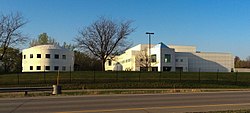Paisley Park
Home and recording studio of Prince, now a museum From Wikipedia, the free encyclopedia
Paisley Park is a 65,000 square foot estate in Chanhassen, Minnesota, United States, once owned by American musician Prince. It was opened to the public as a museum in October 2016.
 Paisley Park in 2015 | |
 | |
| Established | September 11, 1987 |
|---|---|
| Location | 7801 Audubon Rd Chanhassen, Minnesota, U.S. 55317 |
| Website | paisleypark |
History
Summarize
Perspective
Construction of the $10 million[1] complex began in January 1986, and officially opened on September 11, 1987. Designed by architecture firm BOTO Design Inc., of Santa Monica, California, the main designers were architect Bret Thoeny and acoustician Marshall Long.[2][3] The complex shares its name with Prince's 1985 single, "Paisley Park".[4][5]
The Paisley Park studio complex totalled 55,000 square feet by the early 1990s, and includes four recording studios, a 12,500 square-foot sound stage, a video editing suite, rehearsal room, offices,[2] tenant space, and an underground parking garage. Other amenities include an outdoor basketball court,[6] and living quarters.[7][5]
Paisley Park's four recording studios are designated A, B, C, and D. Studio A is a 1,500 square-foot space and originally utilized a 48-channel mixing console, which was later replaced by a 64-channel SSL 6000E. Studio B is a 1,000 square-foot space that was, per Prince's specifications, patterned after Sunset Sound's Studio 3, with a custom-built Automated Processes, Inc. API mixing console.[8] Studio C has a 36-input Soundcraft TS24 console, and Studio D is a small DAW-based room.[2][8]
Initially a private studio used by Prince and Paisley Park Records artists like The Time, Carmen Electra, Jill Jones, Sheila E. and others, Paisley Park's production facilities were used by numerous artists, including Tevin Campbell, Martika, Fine Young Cannibals, Barry Manilow, Steve Miller, Bee Gees, Chris Mars, BoDeans, Madonna, Bob Mould, George Clinton, George Benson, Stone Temple Pilots, Stevie Wonder, R.E.M., and A-ha.[9][10]
After the Paisley Park Records label folded in 1994, Prince continued to live and record at Paisley Park Studios, and he intended to establish Paisley Park as a public venue like Graceland.[11] He was found dead in his estate's elevator on April 21, 2016.[12]
In the basement of Paisley Park, there is a vault that held unreleased material, hundreds of hours of live recordings, music videos, and unheard songs.[13][14] The contents of the vault have been since removed and relocated to a studio in Los Angeles to be restored, remastered, and stored in climate-controlled conditions to be used for later releases.
An urn in the shape of Paisley Park which contains Prince's ashes was on display in Paisley Park's main entrance for a period of time after his death; after being moved into the vault, the urn was brought back out in 2021.[14][7][15][16][17]
Museum
After Prince's death, Paisley Park was turned into a museum open to the public,[18][19] and tours of the Paisley Park Museum started in October 2016. Graceland Holdings, the company that has managed Elvis Presley's Graceland since 1982, organizes the tours.[20] Tours include recording studios, soundstages, and artifacts from Prince's personal archives.[21]
See also
References
External links
Wikiwand - on
Seamless Wikipedia browsing. On steroids.
